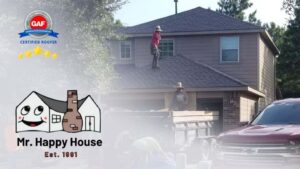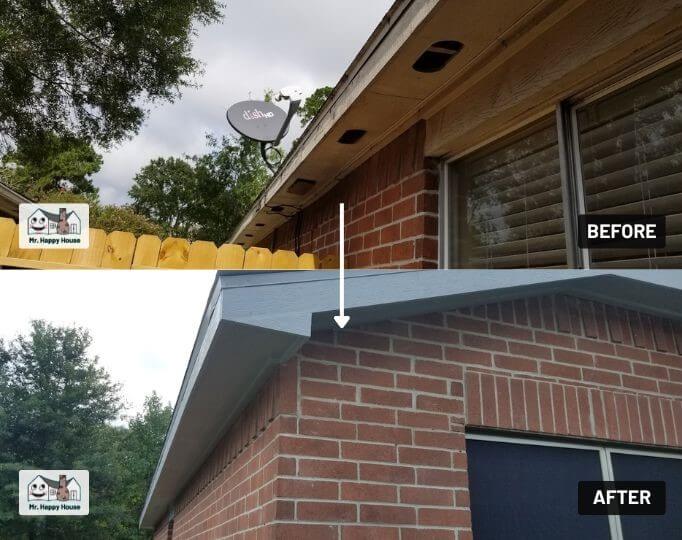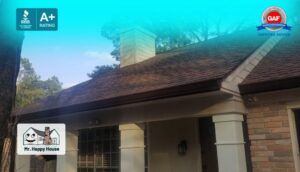
Best GAF Certified Roofers in The Woodlands, TX – Quality Roof Replacement, Gutters & Siding
Best GAF Certified Roofers in The Woodlands, TX – Quality Roof Replacement, Gutters & Siding Best GAF Certified Roofers in The Woodlands, TX – Quality

Fascia boards, those unassuming horizontal elements that line the eaves of your home, often play a role that goes unnoticed until problems arise. In this article, we’ll shine a light on these vital components of your home’s structure and explore the common causes behind rotted fascia boards and what to do if you spot this issue on your home. Whether you’re a seasoned homeowner or a newcomer to the world of home maintenance, understanding these issues and their solutions is crucial.
If you already have rotting fascia boards in your home, it doesn’t always mean that the Fascia is the main issue, but rather could be a “symptom” of an even larger problem. Learning the common causes of rotted fascia will help you determine which direction is best to take when fixing problems like this in your home.
A water leak whether big or small could be one of the primary reasons behind fascia board rot, especially if the damage occurred in a short time period (less than a year). It can seep into the boards through leaks in the roof, faulty gutters, or improper flashing, leading to decay over time, which leads into our other main causes.
High Humidity: In regions with consistently high humidity levels, the air can hold more moisture. This excess moisture can penetrate the fascia boards over time, gradually leading to rot. High humidity is particularly problematic for wood fascia boards, which is why here at Mr. Happy House when we do exterior trim repair or fascia repairs, we recommend installed James Hardie Trim products (example shown down below).
Condensation: Poor attic ventilation or insulation can lead to condensation buildup in the attic space. When warm, moist air from inside the house meets a cooler surface, such as the underside of the roof, condensation forms. If not properly managed, this condensation can drip onto the fascia boards, causing moisture infiltration.
Roof Leaks: Roof leaks are a common source of moisture infiltration. Water can seep through damaged or worn roofing materials and accumulate on the fascia boards, causing them to rot. Regular roof inspections and maintenance are crucial for preventing this issue.
Just like anything else such as getting an oil change and regularly going to the dentist to clean your teeth, your home needs to be routinely checked and maintained, and rotted fascia boards could be caused by:
Gutter and Downspout Neglect: One of the primary maintenance tasks to keep your fascia boards and roof in top shape is gutter and downspout maintenance. When gutters become clogged with leaves, debris, or dirt, rainwater can overflow and spill onto the fascia boards.
This continuous exposure to moisture can cause the fascia boards to deteriorate over time. Neglecting gutter cleaning and downspout maintenance is a key factor in fascia board damage, however this issue can be solved by installing special gutter covers that seamlessly keep leaves and debris out and strictly water into your gutters (video down below).
Failure to Regularly Inspect: Many homeowners don’t inspect their fascia boards regularly. Without periodic visual inspections, it’s challenging to detect early signs of damage, such as rot, cracking, or peeling paint. Ignoring these warning signs can lead to more extensive and costly repairs down the road. You may need to hire a professional roofing and siding contractor to inspect your roof and fascia on a yearly or bi-yearly basis.
Ignoring Paint and Sealant Maintenance: Fascia boards (more so wood fascia boards) benefit from a protective layer of paint or sealant, which shields them from moisture and decay. Neglecting to repaint or reseal the boards when needed can leave them vulnerable to moisture infiltration and eventual rot.
Lack of Pest Control: Neglecting pest control around the home can also contribute to fascia board damage. Pests like termites, carpenter ants, and wood-boring beetles can infiltrate fascia boards and accelerate their decay. Regular pest inspections and treatment can help prevent this issue.
Neglecting Roof Maintenance: The condition of your roof directly impacts the health of your fascia boards. Neglecting roof maintenance, such as fixing damaged or missing shingles, can lead to leaks and water infiltration, which can damage the fascia boards over time.
Ignoring Weather Damage: Severe weather events, such as storms or heavy winds, can damage fascia boards by loosening or tearing them away from the roofline. Failure to promptly address this type of damage can worsen the situation.
From the notorious termite colonies that silently consume the very essence of your fascia to the industrious carpenter ants that excavate tunnels within these vital components, pests can wreak havoc on your home.
Wood-boring beetles, squirrels, and birds, too, play their part in the gradual degradation of fascia boards. Understanding the threats posed by these pests, recognizing the signs of infestation, and implementing preventative measures are essential in preserving the health and longevity of your fascia boards.
Termites: Termites are notorious for causing damage to wooden structures, including fascia boards. These small insects feed on cellulose found in wood, and they can tunnel into the fascia, creating hidden damage. By the time the damage becomes visible, it’s often extensive. Termite infestations are a significant threat to the structural integrity of a home, making regular termite inspections and treatments essential.
Carpenter Ants: Carpenter ants don’t eat wood, but they excavate it to create nesting galleries. Over time, this tunneling can weaken fascia boards and make them more susceptible to moisture infiltration and rot. Signs of a carpenter ant infestation include sawdust-like frass and small openings where they enter and exit.
Wood-Boring Beetles: Various species of wood-boring beetles can infest fascia boards. These beetles lay their eggs in cracks or crevices in the wood, and the larvae bore into the wood as they grow. Their tunneling can weaken the fascia, and the exit holes they create may become entry points for moisture.
Squirrels and Birds: Larger pests like squirrels and birds can also cause damage to fascia boards. Squirrels may gnaw on the boards to gain access to the attic, and birds can create nests in or on the fascia. Their activity can lead to physical damage and potential moisture issues.
Treatment and Repair: If a pest infestation is discovered, prompt action is crucial. Depending on the type of pest and the extent of the damage, treatment may involve insecticides, bait traps, or even structural repairs. Damaged fascia boards may need to be replaced to ensure the structural integrity of the home.
Over the years, fascia boards are exposed to the elements, including sunlight, rain, wind, and temperature fluctuations. This exposure gradually breaks down the materials, causing them to weaken and lose their protective qualities. As a result, fascia boards become more vulnerable to damage and decay (especially wood fascia boards).
Traditional wooden fascia boards, often made from pine, cedar, or redwood, are particularly susceptible to age-related degradation. Wood can warp, crack, and split as it ages, creating openings for moisture infiltration and pest infestations. Regular painting or sealing is essential to prolong the life of wooden fascia boards.
Paint and Finish: The quality and maintenance of the paint or finish on fascia boards can significantly affect their resistance to degradation. Cracked or peeling paint exposes the underlying wood or material to moisture, accelerating deterioration.
The correct installation of fascia boards is critical to their long-term performance and resistance to damage. When fascia boards are improperly installed, they become susceptible to various issues that can lead to deterioration. Here’s a closer look at how improper installation can contribute to fascia board problems:
Inadequate Flashing: Proper flashing is essential to prevent water from infiltrating behind the fascia boards. If flashing is incorrectly installed or missing altogether, rainwater can seep into the gaps between the fascia boards and the underlying structure. This moisture can lead to rot and other forms of damage over time.
Poor Attachment: Fascia boards should be securely fastened to the roof trusses or rafters using appropriate fasteners. Improper attachment can result in loose or sagging fascia boards, making them more susceptible to damage from wind, moisture, and pests.
Lack of Proper Ventilation: Adequate ventilation beneath the roofline is crucial to prevent moisture buildup in the attic space. If fascia boards are installed without providing proper soffit ventilation, it can lead to condensation, mold growth, and ultimately, damage to the boards.
Incorrect Material Selection: Choosing the wrong type of material for fascia boards or using low-quality materials can lead to premature deterioration. It’s important to select materials that are suitable for the local climate and have the necessary resistance to moisture and pests.
DIY Installation Errors: DIY installations are prone to mistakes, especially when homeowners lack experience. Errors in measuring, cutting, and fastening can compromise the structural integrity of the fascia boards.
To address improper installation issues, homeowners should consider the following:
Professional Inspection: Hiring a professional inspector or contractor to assess the installation of fascia boards can identify any improper installation issues that may need correction.
Reinstallation or Repair: If significant installation errors are detected, it may be necessary to reinstall or repair the fascia boards properly. This can involve adjusting the slope, adding or replacing flashing, and ensuring secure attachment.
Soffit Ventilation: Proper soffit ventilation should be installed to prevent moisture buildup in the attic and minimize the risk of damage to fascia boards.
The functionality and effectiveness of gutter systems are closely tied to the health of your fascia boards. When gutter systems are improperly designed, installed, or maintained, they can contribute to fascia board damage and deterioration. Here’s a more detailed exploration of how improper gutter systems can impact fascia boards:
Clogged Gutters: One of the most common issues with gutter systems is the accumulation of debris like leaves, twigs, and dirt. When gutters become clogged, they cannot effectively channel rainwater away from the roof and fascia boards. The overflow of water can cascade directly onto the fascia boards, leading to moisture infiltration, rot, and structural damage over time.
Inadequate Gutter Slope: Gutters should be installed with a slight slope toward the downspouts to ensure proper water flow. If the gutters are not sloped correctly or if they sag due to improper attachment, water may pool in certain areas, increasing the risk of overflow and damage to the fascia boards.
Missing or Damaged Gutter Guards: Gutter guards or screens are designed to prevent debris from entering the gutters while allowing water to flow through. When these guards are missing or damaged, gutters can quickly accumulate debris, leading to clogs and subsequent overflow onto the fascia boards.
Downspout Issues: Inadequate downspout placement or insufficient numbers of downspouts can result in poor water drainage from the gutters. This can lead to excessive water runoff, which can damage fascia boards as well as the foundation and landscaping near the house.
Leaky or Damaged Gutters: Gutter systems that leak or have damaged sections can allow water to escape and trickle down the fascia boards, causing deterioration over time.
Improperly Sized Gutters: Gutters should be appropriately sized to handle the volume of rainwater that drains from the roof. When gutters are too small for the roof’s surface area, they may become overwhelmed during heavy rainfall, leading to overflow and potential damage to the fascia boards.
To address issues related to improper gutter systems and prevent damage to fascia boards, as a homeowner, you should consider the following:
Regular Cleaning and Maintenance: Routine gutter cleaning and maintenance, particularly during the fall when leaves are abundant, can prevent clogs and ensure proper water flow.
Installation of Quality Gutter Covers: Installing quality gutter covers can help keep debris out of the gutters, reducing the frequency of cleaning required.
Correct Sloping and Attachment: Ensuring that gutters are correctly sloped and securely attached can prevent water from pooling and overflowing.
Repair or Replacement: Leaky, damaged, or improperly sized gutters should be repaired or replaced as needed to maintain effective water drainage and protect fascia boards.
In the intricate web of a home’s structural components, fascia boards are often the most neglected when it comes to maintaining the structural integrity of your home and the roof. Remember to follow the points listed in this article if you have rotted fascia boards and your home will continue to stand strong, protected from the elements, and looking great with a nice curb appeal.
We hoped you loved this article on what is the purpose of a soffit, please share and tune in for more roofing, siding, and house painting content!
Our Services:













Best GAF Certified Roofers in The Woodlands, TX – Quality Roof Replacement, Gutters & Siding
Best GAF Certified Roofers in The Woodlands, TX – Quality Roof Replacement, Gutters & Siding Best GAF Certified Roofers in The Woodlands, TX – Quality

Are Gutters Part of the Roofing System?
Are Gutters Part of the Roofing System? Are Gutters Part of the Roofing System? When it comes to home maintenance, gutters often seem like a

Why James Hardie is The Best Option for Home Siding
Why James Hardie is The Best Option for Home Siding Why James Hardie is The Best Option for Home Siding James Hardie stands out whether











